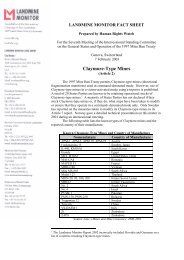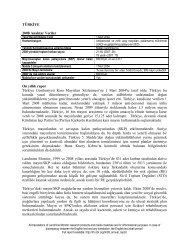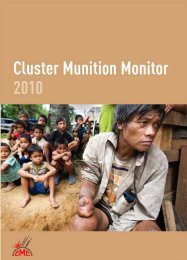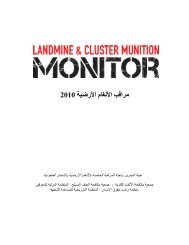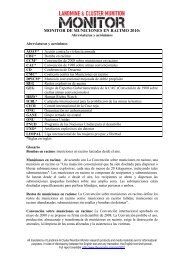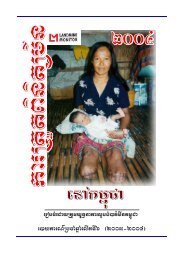Download PDF - Landmine and Cluster Munition Monitor
Download PDF - Landmine and Cluster Munition Monitor
Download PDF - Landmine and Cluster Munition Monitor
Create successful ePaper yourself
Turn your PDF publications into a flip-book with our unique Google optimized e-Paper software.
<strong>Cluster</strong> <strong>Munition</strong> <strong>Monitor</strong> 2012<br />
States/areas with cluster munition casualties (as of 31 July 2012)<br />
Africa Americas Asia<br />
Europe, Caucasus,<br />
<strong>and</strong> Central Asia<br />
Angola Columbia Afghanistan Albania Iraq<br />
Chad Cambodia Bosnia <strong>and</strong><br />
Herzegovina<br />
DRC Lao PDR Croatia Kuwait<br />
Eritrea Vietnam Georgia Lebanon<br />
Ethiopia Montenegro Libya<br />
Guinea-Bissau Russia Syria<br />
Middle East <strong>and</strong><br />
North Africa<br />
Mozambique Serbia Western Sahara<br />
Sierra Leone<br />
South Sudan<br />
Sudan<br />
Ug<strong>and</strong>a<br />
Tajikistan<br />
Kosovo<br />
Nagorno-Karabakh<br />
Note: Convention on <strong>Cluster</strong> <strong>Munition</strong> States Parties <strong>and</strong> signatories in bold; non-signatories in plain text; other areas in italics<br />
Of the 30 states with casualties that therefore have responsibility for cluster munition victims, ten are States Parties to<br />
the Convention on <strong>Cluster</strong> <strong>Munition</strong>s (Afghanistan, Albania, Bosnia <strong>and</strong> Herzegovina, Croatia, Guinea-Bissau, Lao PDR,<br />
Lebanon, Montenegro, Mozambique, <strong>and</strong> Sierra Leone) <strong>and</strong> six have signed, but not yet ratified the convention (Angola,<br />
Chad, Colombia, Democratic Republic of the Congo [DRC], Iraq, <strong>and</strong> Ug<strong>and</strong>a). Compared to 29 states with casualties<br />
reported in 2011, this is an increase of one country (Colombia). 4<br />
According to the convention, cluster munition victims are defined as all persons who have been killed or suffered<br />
physical or psychological injury, economic loss, social marginalization, or substantial impairment of the realization<br />
of their rights caused by the use of cluster munitions. 5 The definition of a “victim” encompasses the individuals, their<br />
families, <strong>and</strong> affected communities, yet little is known about the number of families <strong>and</strong> communities of survivors<br />
affected by cluster munitions; methods for collecting data on this subject remain largely undefined. The needs of families<br />
<strong>and</strong> communities are likely to be extensive.<br />
There are no comprehensive, reliable statistics on cluster munition casualties, the people who were killed or injured<br />
by cluster munitions, <strong>and</strong> there has been inadequate reporting <strong>and</strong> massive underreporting of both civilian <strong>and</strong> military<br />
casualties. 6 In 2011, no affected states attempted to report the total or estimated number of cluster munition victims<br />
living in their territory <strong>and</strong> most States Parties have not attempted to provide data on the number of cluster munition<br />
survivors who are still alive <strong>and</strong> in need of assistance. However, Albania, Iraq, Lao PDR, <strong>and</strong> Lebanon reported efforts<br />
to disaggregate this information.<br />
At least 17,194 cluster munition casualties have been reported globally through the end of 2011, as listed in the<br />
following table by region. Yet a far greater, <strong>and</strong> probably a better indicator of the number of cluster munition casualties,<br />
is the estimated total of between 20,000 <strong>and</strong> 54,000. Other projections range from 58,000 to 85,000 casualties or more,<br />
but some country totals are based on extrapolations <strong>and</strong> data may be inflated. 7<br />
Israel<br />
4<br />
The addition of Colombia follows the Inter-American Commission’s investigation into the use of a cluster munition in Santo Domingo,<br />
Colombia in 1998, which made more details available on cluster munition casualties. Inter-American Commission on Human Rights, Case<br />
No. 12.416, Santo Domingo Massacre v. Republic of Colombia, 8 July 2011.<br />
5<br />
<strong>Cluster</strong> munitions victims include survivors (people who were injured by cluster munitions or their explosive remnants <strong>and</strong> lived), other<br />
persons directly impacted by cluster munitions, as well as their affected families <strong>and</strong> communities. As a result of their injuries, most cluster<br />
munition survivors are also persons with disabilities. In the <strong>Monitor</strong>, the term “cluster munition casualties” is used to refer both to people<br />
killed <strong>and</strong> people injured as a result of cluster munition use or cluster munition remnants, mostly explosive submunitions.<br />
6<br />
In most countries, when identified, casualties from unexploded submunitions have been recorded as casualties from explosive remnants of<br />
war (ERW) without differentiating from other types of ERW.<br />
7<br />
HI, Circle of Impact: The Fatal Footprint of <strong>Cluster</strong> <strong>Munition</strong>s on People <strong>and</strong> Communities (Brussels: HI, 2007).<br />
52



